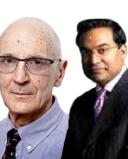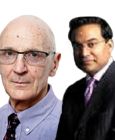Body Language
The Psychology of the Trump Mug Shot
Can research explain why Trump and Mona Lisa face a different way?
Posted August 28, 2023 Reviewed by Gary Drevitch
Key points
- Faces and facial expressions are relied upon to detect others' emotional states and trustworthiness.
- Facial expressions are not symmetrically represented on faces.
- Studies analysing hundreds of facial images find a tendency for heads to be tilted in particular directions.

An official photograph of Donald Trump following his arrest in Georgia, the first ever so-called "mug shot" of a former U.S. president, has become a global phenomenon. But what might actually be revealed by the mug shot, from a scientific standpoint, given recent academic research into facial expression and appearance?
Academics specialising in face perception would notice that Donald Trump has oriented his face slightly to his left, and therefore is showing slightly more of the right side of his face to the viewer.
Mike Nicholls of Flinders University in Melbourne, Australia, has rigorously examined whether those posing for photographs tend to turn their heads to one side or the other. In perhaps the most famous portrait in the world, the Mona Lisa, painted by Lenardo Da Vinci in 1503, the enigmatic model turns so that she shows her left cheek more than her right. As a result, it is her left eye which is closer to the centre of the picture than her right.
A study published in the journal Nature examined 1474 painted portraits and found that 68 percent of female and 56 percent of male portraits were painted showing more of the left side of the face than the right.
Therefore, this apparently innocuous head tilt of Donald Trump, in the opposite direction, may have deeper significance. When Nicholls's team asked people to pose for a family portrait, and to express as much emotion as possible, participants tended to tilt their head to their right, exposing more of the face’s left side, just like the Mona Lisa. When asked to pose as scientists, and to avoid showing emotion, participants tended to present their right side, and therefore tilt their expression to the left. The study also found that official portraits of scientists don’t show this tendency of the sitter to tilt their head to the right; instead they tend to look more face on.
The researchers concluded that people intuitively know which side of the face tends to reveal more emotion, and naturally angle their heads in one direction more than the other for portraiture.
From this and other research Nicholls concluded that when being photographed or painted, people who want to express emotion turn their left cheek to the viewer, but when trying to hide emotion, there is an opposite tendency to show the right side.
It is important to emphasise that these results emerged from averaged data over a large number of images sampled, and so they represent group effects; it would be erroneous to conclude that in every single picture you could work out whether any one particular person is trying to express or hide emotion, simply from the tilt of their head. However, it is also interesting to note that in other research focusing on which eye of the subject is nearer the centre of a photograph or painting there is convergence with the finding of the left-leaning tilt of the head and emotional expression.
Another study published in Nature examined the implications of the fact that the importance of the centre of the canvas has long been appreciated in art, as has the special significance of the eyes in revealing the personality of portrait subjects. This study examined portraits painted across the past 600 years and found that one eye is consistently centred horizontally in the canvas.
Nicholls has found that when one eye in a painted portrait does fall in the centre of the picture, in almost two-thirds of cases that eye tends to be the left one, meaning the model has turned to the right, just as in the Mona Lisa.
Interestingly, in Trump’s mug shot the eye that is nearer the centre of the picture is his right eye; indeed it is almost dead in the centre of the original picture.
Psychologists Matia Okubo, Kenta Ishikawa, and Akihiro Kobayashi of Senshu University in Japan have published a series of studies recently in which they argue that emotional expression is not symmetrically portrayed in the face, and that the left side is more emotionally expressive than the right. This may have something to do with the contention that the left and right hemispheres of the brain may differ in their specialisation for emotional expression and detection. This team argues that if the left side of the face is more reactive to transient emotions, then in fact it may be better to focus on the right side of the expression if you are trying to work out the real longer-term emotional state of a person, rather than what emotion they are trying to portray or project to the world in the moment.
The less emotionally reactive right side of the face, these researchers argue, tends to be a better place to look for more stable underlying personality traits.
And indeed, published research has found that if you are trying to accurately read someone’s mind—in terms of figuring out their actual emotional state as opposed to what they are fronting—you're better off focusing on the right side of a target’s countenance.
But this team of Japanese psychologists has also been interested in the issue of inferring trustworthiness from facial expression. This is perhaps of supreme importance when an electorate is trying to evaluate a political candidate. The team first established in their experiments just how trustworthy a group of people really were and then examined how accurate others could be in assessing levels of trustworthiness. They found a strong tendency of smiling to put people off the scent—when someone smiles it seems to be more difficult for others to accurately infer how trustworthy they are—which means that those who are not trustworthy should smile a lot in order to cover their tracks.
When the target in the experiment was asked to facially express anger, this emotion seemed to help those asked to assess trustworthiness in more accurately spotting who to trust, and who not to, from observing faces.
The best combination of all in helping people figure out who to trust was when the target expressed anger as their facial expression, and turned their faces more to the left, showing the right more.
In Trump’s mug shot it is universally agreed that he looks furious, and there is no doubt he has turned to the left, revealing more of the right side of his face. Basically, it is almost as it he is taking part in the experiments of the Japanese psychologists in that he is presenting the best opportunity for the viewer to evaluate his trustworthiness. These studies are not asserting that turning to one side or the other in a picture reveals how trustworthy you are. Instead, this research is about whether head tilt tells us something about whether people are trying to hide an emotion, and whether expressing certain positive or negative emotions also serve to helpfully reveal or hide trustworthiness.
BBC News has just reported that Trump's election campaign claims it has raised $7.1m (£5.6m) since his mug shot was taken on Thursday. Much of the money comes from merchandise such as mugs, T-shirts, and drink coolers bearing the former president's scowling face.
Many of the other defendants in the Georgia election case have also had their mug shots taken and disseminated widely across the internet, but unlike the ex-president, in none of the other pictures is anyone doing anything other than facing the camera symmetrically; in some they are smiling.
Whatever one may think of Trump, he appears from this evidence at least, apparenly to be a better amateur psychologist than many others in the public eye.
References
Nicholls, M. E. R., Clode, D., Wood, S., & Wood, A. (1999). Laterality of expression in portraiture: Putting your best cheek forward. Proceedings of the Royal Society B: Biological Sciences, 266, 1517–1522. doi:10.1098/rspb.1999.0809
MCMANUS, I., HUMPHREY, N. Turning the Left Cheek. Nature 243, 271–272 (1973). https://doi.org/10.1038/243271a0
Tyler, C. Painters centre one eye in portraits. Nature 392, 877–878 (1998). https://doi.org/10.1038/31833
Which cheek to turn? The effect of gender and emotional expressivity on posing behavior. Nicholls ME , Clode D , Lindell AK , Wood AG Brain and Cognition, 01 Mar 2002, 48(2-3):480-484 PMID: 12030492
Lindell, A. K. (2013). The silent social/emotional signals in left and right cheek poses: A literature review. Laterality: Asymmetries of Body, Brain and Cognition, 18, 612–624. doi:10.1080/1357650X.2012.737330
Okubo, M., Ishikawa, K., & Kobayashi, A. (2013). No trust on the left side: Hemifacial asymmetries for trustworthiness and emotional expressions. Brain and Cognition, 82, 181–186. doi:10.1016/j.bandc.2013.04.004
Okubo, M., Ishikawa, K., Kobayashi, A., & Suzuki, H. (2017). Can I trust you? Laterality of facial trustworthiness in an economic game. Journal of Nonverbal Behavior, 36, 217–225. doi:10.1007/s10919-012-0134-9
Indersmitten, T., & Gur, R. (2003). Emotion processing in chimeric faces: Hemispheric asymmetries in expression and recognition of emotions. Journal of Neuroscience, 23, 3820–3825.
Okubo, M., Kobayashi, A., & Ishikawa, K. (2012). A fake smile thwarts cheater detection. Journal of Nonverbal Behavior, 36, 217–225. doi:10.1007/s10919-012-0134-9




